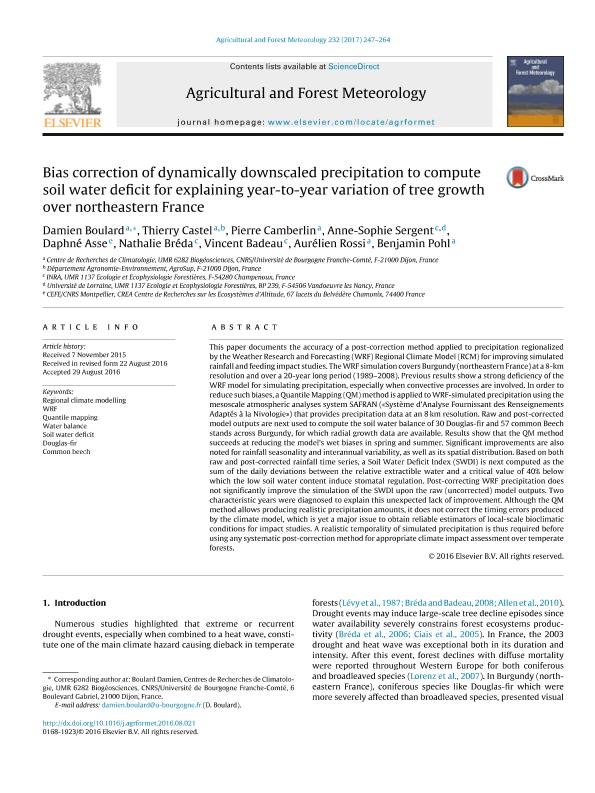Mostrar el registro sencillo del ítem
dc.contributor.author
Boulard, Damien
dc.contributor.author
Castel, Thierry
dc.contributor.author
Camberlin, Pierre
dc.contributor.author
Sergent, Anne Sophie

dc.contributor.author
Asse, Daphné
dc.contributor.author
Bréda, Nathalie
dc.contributor.author
Badeau, Vincent
dc.contributor.author
Rossi, Aurélien
dc.contributor.author
Pohl, Benjamin
dc.date.available
2018-11-28T20:22:16Z
dc.date.issued
2017-01-15
dc.identifier.citation
Boulard, Damien; Castel, Thierry; Camberlin, Pierre; Sergent, Anne Sophie; Asse, Daphné; et al.; Bias correction of dynamically downscaled precipitation to compute soil water deficit for explaining year-to-year variation of tree growth over northeastern France; Elsevier Science; Agricultural And Forest Meteorology; 232; 15-1-2017; 247-264
dc.identifier.issn
0168-1923
dc.identifier.uri
http://hdl.handle.net/11336/65536
dc.description.abstract
This paper documents the accuracy of a post-correction method applied to precipitation regionalized by the Weather Research and Forecasting (WRF) Regional Climate Model (RCM) for improving simulated rainfall and feeding impact studies. The WRF simulation covers Burgundy (northeastern France) at a 8-km resolution and over a 20-year long period (1989–2008). Previous results show a strong deficiency of the WRF model for simulating precipitation, especially when convective processes are involved. In order to reduce such biases, a Quantile Mapping (QM) method is applied to WRF-simulated precipitation using the mesoscale atmospheric analyses system SAFRAN («Système d'Analyse Fournissant des Renseignements Adaptés à la Nivologie») that provides precipitation data at an 8 km resolution. Raw and post-corrected model outputs are next used to compute the soil water balance of 30 Douglas-fir and 57 common Beech stands across Burgundy, for which radial growth data are available. Results show that the QM method succeeds at reducing the model's wet biases in spring and summer. Significant improvements are also noted for rainfall seasonality and interannual variability, as well as its spatial distribution. Based on both raw and post-corrected rainfall time series, a Soil Water Deficit Index (SWDI) is next computed as the sum of the daily deviations between the relative extractible water and a critical value of 40% below which the low soil water content induce stomatal regulation. Post-correcting WRF precipitation does not significantly improve the simulation of the SWDI upon the raw (uncorrected) model outputs. Two characteristic years were diagnosed to explain this unexpected lack of improvement. Although the QM method allows producing realistic precipitation amounts, it does not correct the timing errors produced by the climate model, which is yet a major issue to obtain reliable estimators of local-scale bioclimatic conditions for impact studies. A realistic temporality of simulated precipitation is thus required before using any systematic post-correction method for appropriate climate impact assessment over temperate forests.
dc.format
application/pdf
dc.language.iso
eng
dc.publisher
Elsevier Science

dc.rights
info:eu-repo/semantics/openAccess
dc.rights.uri
https://creativecommons.org/licenses/by-nc-nd/2.5/ar/
dc.subject
Common Beech
dc.subject
Douglas-Fir
dc.subject
Quantile Mapping
dc.subject
Regional Climate Modelling
dc.subject
Soil Water Deficit
dc.subject
Water Balance
dc.subject
Wrf
dc.subject.classification
Meteorología y Ciencias Atmosféricas

dc.subject.classification
Ciencias de la Tierra y relacionadas con el Medio Ambiente

dc.subject.classification
CIENCIAS NATURALES Y EXACTAS

dc.title
Bias correction of dynamically downscaled precipitation to compute soil water deficit for explaining year-to-year variation of tree growth over northeastern France
dc.type
info:eu-repo/semantics/article
dc.type
info:ar-repo/semantics/artículo
dc.type
info:eu-repo/semantics/publishedVersion
dc.date.updated
2018-10-29T15:10:30Z
dc.journal.volume
232
dc.journal.pagination
247-264
dc.journal.pais
Países Bajos

dc.journal.ciudad
Amsterdam
dc.description.fil
Fil: Boulard, Damien. Universite de Bourgogne; Francia
dc.description.fil
Fil: Castel, Thierry. Universite de Bourgogne; Francia
dc.description.fil
Fil: Camberlin, Pierre. Universite de Bourgogne; Francia
dc.description.fil
Fil: Sergent, Anne Sophie. Institut National de la Recherche Agronomique; Francia. Instituto Nacional de Tecnología Agropecuaria. Centro Regional Patagonia Norte. Estación Experimental Agropecuaria San Carlos de Bariloche; Argentina
dc.description.fil
Fil: Asse, Daphné. Crea Centre de Recherches Sur Les Ecosystèmes Daltitud; Francia
dc.description.fil
Fil: Bréda, Nathalie. Institut National de la Recherche Agronomique; Francia
dc.description.fil
Fil: Badeau, Vincent. Institut National de la Recherche Agronomique; Francia
dc.description.fil
Fil: Rossi, Aurélien. Universite de Bourgogne; Francia
dc.description.fil
Fil: Pohl, Benjamin. Universite de Bourgogne; Francia
dc.journal.title
Agricultural And Forest Meteorology

dc.relation.alternativeid
info:eu-repo/semantics/altIdentifier/doi/http://dx.doi.org/10.1016/j.agrformet.2016.08.021
dc.relation.alternativeid
info:eu-repo/semantics/altIdentifier/url/https://www.sciencedirect.com/science/article/pii/S0168192316303768
Archivos asociados
